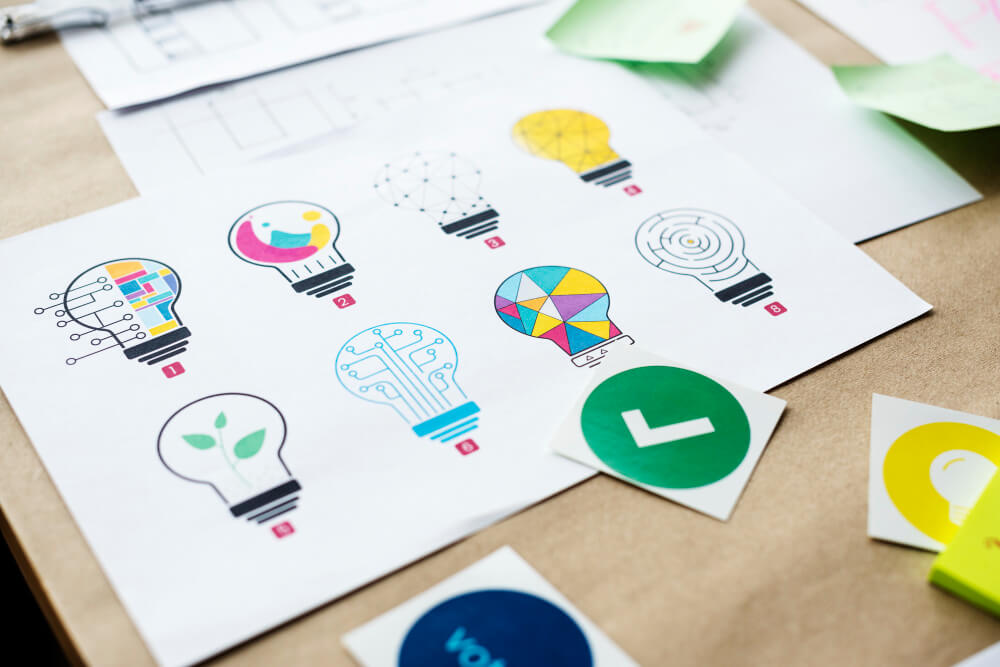[Design] Thinking
As a design thinking agency, we give shape the ideologies of humans, as per the market analysis.
Get Your Free Consultation
As creative heads, we all have our abstract ideas, imaginations, inspirations, influences, observations, and likewise. Our ideas about business, a graphic, a brand, an app, a website, or a social media page develop from these various observations, imaginations, influences, inspirations, and abstracts our mind conspires of… All these wired theories that our mind keeps on wiring need to be defined, need to have a value add, needs to be developed it needs to be re-wired…but how?
It’s pretty much clear that one needs to put all these ideas into a process and give them a direction or a process that can add value to them. But the question here is how to do it, what to do about it?
Have you ever heard about the term mood board, basically designers create these mood boards, as in they-the designers or creative heads or even for that matter brand strategists, and marketers, allocate all their scribbles, their inspirational and influential cut-outs, observations, imaginary sketches, and drawings in one place on a board that will stay in front of their eyes and helps them create the needed product!
Writers also for that matter, they will paste sticky notes of pointers or record something that they observe, write notes about it on their phones, speak up their minds and record it so that they don’t forget about it, and can write the desired story for their book by giving all these accumulated materials a direction.
Marketing & Branding also works similarly. The product or service that the brand caters to needs to be given a personality that the target audience of the brand can perceive easily and they can relate to it on an everyday basis.
Now all these mood boards that are prepared via all these abstracts, need a direction or process and that process is called design thinking. Design Thinking defines the material collected… But how does this design thinking works?
As we all are witnessing that the world has shifted and shifted now and then to Digitalisation. Thus, with some minor modifications to already common software development practices, design thinking can have large benefits for customer service operations and customer experience.
Design Thinking is synonymous with human behaviour. Design thinking can begin by observation of a person or group of people in their day-to-day environment to see how they consciously or unconsciously interact with a product, physical or digital, and “use” it to meet their needs, some of which can be hidden or much harder to identify.
Marketers define Design thinking as “the natural outgrowth of creative marketing and branding teams, and it’s beginning to catch on in other sectors of industry as a way of increasing productivity and fostering innovation.”
Here are a few Components of Design Thinking:
Develop [Empathy]
As the best design thinking agency, it is all about defining a process for the raw material collected & developed by the human minds, the first stage begins with empathy. Empathizing is all about experiencing the feelings of one another.
For example, a designer like Sabyasachi Mukherji has an established brand for fashion and is a well-known name in the Indian Wedding couture. Now, when you visit his social media pages, you will observe that his designs and his posts speak emotions, he describes the journey behind every couture piece he has designed. This makes his audience relate to him and more than that as a designer he understands the design thinking agency process and how.
Well, he is into wedding couture, so weddings are all about emotions in India, so playing the emotional card of how the piece was developed through the touches of holy Banaras, with the embroidery or royalty makes his design process stand out and makes instant connect with the audience.
Thus, it is all about setting the relatability tone for the brand. Relatability is about letting people understand similar personal experiences and emotions. Empathy helps a brand to solve problems from the end user’s point of view. This means putting human needs and problems before everything else, and when you start doing this, you can automatically give a definition to your abstract ideas.
Define [The Problem]
[ Ideate]
Now once the target audience is defined, and the product ideology is set it’s time to ideate it. Defining the problems, makes us understand what exactly the people want to perceive, and thus the next step is all about brainstorming ideas accordingly to ideate. While ideating it’s important to never lose sight of the customer or user’s needs and wants. In the ideation phase, we believe in taking ideas from every department, as you never know if there might be someone, who is facing the same problem and can give us a big idea that can create impactful solutions.

[ Prototype]
Now once the ideation is done, the mood board is set, empathizing and defining the audience and the products as per the segmentation is done, it’s time for prototyping systems in place, as in doing trials and errors regarding the process, looking after the processes and analyzing the results that you get through it, focusing on whether positive results are delivered or negative and if it’s negative then analyzing the errors and finding the why behind the negative to make it positive.
Like, for example on Instagram there are many ways of marketing a brand, like via stories, posts, reels, and likewise. Even if the brand follows advertising the brand and is unable to get the needed result then it’s a waste of effort and resources, in the prototype system the marketers usually check which way of marketing is working for their target audience as there are few brands whose target audience are more into stories, then there are some other brands whose target audience are more into reels, and posts, thus while advertising or marketing a marketer needs to understand what is working and start with that prototype marketing for their brand.
Trial and Error is part and parcel of design thinking agency and every marketing strategy. Thus, trying and testing the ideas developed, creating options, and testing them on various devices and people is very important. Trying these different idea options on people helps a brand to understand enhancement needed, upgradations needed, and likewise.

[Test] Your Solutions
Once the trials are done, the errors are detected, and then comes the process of testing. Yes, this is the most important stage. Thus, identifying the right solution is highly important. Once the problem is identified, it’s important to act upon it and refine and improve the solution. In this process, it’s important to seek feedback from users and project stakeholders. This phase is iterative. Our team will circle back and retry different versions of prototypes until the final result combines design and development into a functional unit that satisfies what users want.
Once the problem is identified, and the solution is developed, there again comes the point to finally test it and initiate a testing phase to bring in end users. In this process, we make sure to observe how it works, how users react, and whether it solves the initial problem satisfactorily. And as per the observation, and collection of feedback on the same, only after identifying the bugs/problems, we fix the issues accordingly. If the solution works to the specifications defined by the design team, you already know you have a successful launch in your hands.
So, when are you adapting to the process, as a design thinking agency, it’s the best way to develop a brand language for your brand that will create an impact out there.

